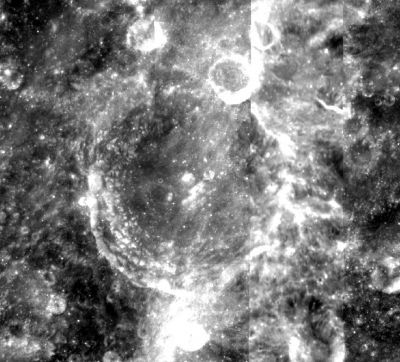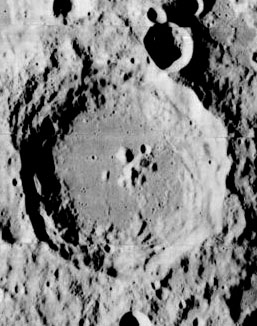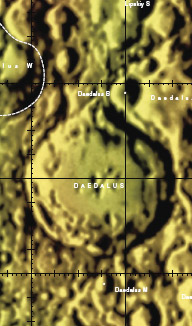Difference between revisions of "Daedalus"
| Line 12: | Line 12: | ||
|} | |} | ||
'''Left:''' [http://www.mapaplanet.org/explorer-bin/explorer.cgi?map=Moon&layers=moon_clementine_base_v2&info=NO&advoption=YES&sizeSelector=imageSize&lines=684&samples=1418&Resolution=35.8490566037736&r=1&g=1&b=1&projection=SIMP&grid=none&stretch=auto&north=-11.33&south=-1.79&west=170.33&east=190.08¢er_lat=0¢er=180.205&defaultcenter=on Clementine] image. '''Middle:''' [http://www.lpi.usra.edu/resources/lunarorbiter/images/preview/2033_med.jpg Lunar Orbiter 2] Frame 2033 image from [http://www.lpi.usra.edu/ LPI]. '''Right:''' [http://planetarynames.wr.usgs.gov/images/Lunar/lac_86.pdf Color-coded topography LAC 86] image from [[USGS%20Digital%20Atlas|USGS Digital Atlas]].<div id="toc"> | '''Left:''' [http://www.mapaplanet.org/explorer-bin/explorer.cgi?map=Moon&layers=moon_clementine_base_v2&info=NO&advoption=YES&sizeSelector=imageSize&lines=684&samples=1418&Resolution=35.8490566037736&r=1&g=1&b=1&projection=SIMP&grid=none&stretch=auto&north=-11.33&south=-1.79&west=170.33&east=190.08¢er_lat=0¢er=180.205&defaultcenter=on Clementine] image. '''Middle:''' [http://www.lpi.usra.edu/resources/lunarorbiter/images/preview/2033_med.jpg Lunar Orbiter 2] Frame 2033 image from [http://www.lpi.usra.edu/ LPI]. '''Right:''' [http://planetarynames.wr.usgs.gov/images/Lunar/lac_86.pdf Color-coded topography LAC 86] image from [[USGS%20Digital%20Atlas|USGS Digital Atlas]].<div id="toc"> | ||
| − | + | <br /> <br /> | |
| − | |||
==Images== | ==Images== | ||
[http://www.lpod.org/coppermine/thumbnails.php?album=search&type=full&search=Daedalus LPOD Photo Gallery] [http://www.lpi.usra.edu/resources/lunar_orbiter/bin/srch_nam.shtml?Daedalus%7C0 Lunar Orbiter Images] [http://www.lpi.usra.edu/resources/apollo/search/feature/?feature=Daedalus Apollo Images]<br /> - [http://www.hq.nasa.gov/office/pao/History/alsj/a11/AS11-44-6609.jpg AS11-44-6609] and [http://www.hq.nasa.gov/office/pao/History/alsj/a11/AS11-44-6611.jpg AS11-44-6611] are two of the most frequently reproduced and most well-known orbital ''Hasselblad'' photographs of the moon's Far Side (both photographs show the area just southward of '''Lipsky''', which is the antipode of '''Sinus Medii''' on the moon's Near Side). The large pronounced crater in both photographs is '''Daedalus'''. Looking south.<br /> - Apollo 17's northward looking oblique ''Fairchild'' camera frame [http://www.lpi.usra.edu/resources/apollo/frame/?AS17-M-0828 AS17-M-0828] shows '''Daedalus''' near the central part of the curved horizon.<br /> Additional research orbital Apollo photography: Danny Caes<br /> <br /> | [http://www.lpod.org/coppermine/thumbnails.php?album=search&type=full&search=Daedalus LPOD Photo Gallery] [http://www.lpi.usra.edu/resources/lunar_orbiter/bin/srch_nam.shtml?Daedalus%7C0 Lunar Orbiter Images] [http://www.lpi.usra.edu/resources/apollo/search/feature/?feature=Daedalus Apollo Images]<br /> - [http://www.hq.nasa.gov/office/pao/History/alsj/a11/AS11-44-6609.jpg AS11-44-6609] and [http://www.hq.nasa.gov/office/pao/History/alsj/a11/AS11-44-6611.jpg AS11-44-6611] are two of the most frequently reproduced and most well-known orbital ''Hasselblad'' photographs of the moon's Far Side (both photographs show the area just southward of '''Lipsky''', which is the antipode of '''Sinus Medii''' on the moon's Near Side). The large pronounced crater in both photographs is '''Daedalus'''. Looking south.<br /> - Apollo 17's northward looking oblique ''Fairchild'' camera frame [http://www.lpi.usra.edu/resources/apollo/frame/?AS17-M-0828 AS17-M-0828] shows '''Daedalus''' near the central part of the curved horizon.<br /> Additional research orbital Apollo photography: Danny Caes<br /> <br /> | ||
| Line 37: | Line 36: | ||
<br /> <br /> | <br /> <br /> | ||
---- | ---- | ||
| − | + | </div> | |
Revision as of 17:19, 15 April 2018
Contents
Daedalus
| Lat: 5.9°S, Long: 179.4°E, Diam: 93 km, Depth: km, Rükl: (farside) | ||
Images
LPOD Photo Gallery Lunar Orbiter Images Apollo Images
- AS11-44-6609 and AS11-44-6611 are two of the most frequently reproduced and most well-known orbital Hasselblad photographs of the moon's Far Side (both photographs show the area just southward of Lipsky, which is the antipode of Sinus Medii on the moon's Near Side). The large pronounced crater in both photographs is Daedalus. Looking south.
- Apollo 17's northward looking oblique Fairchild camera frame AS17-M-0828 shows Daedalus near the central part of the curved horizon.
Additional research orbital Apollo photography: Danny Caes
Maps
(LAC zone 86A3) USGS Digital Atlas PDF
Description
Daedalus is a crater of the Early Imbrium period (3.75 to 3.2 bn years ago). It lies some 500 kilometres away west of the Korolev Basin and some 300 kilometres away north of the outer ring of the South Pole Aitken Basin to its south -- both respectively Nectarian (3.92 to 3.85 bn years) and pre-Nectarian (4.6 to 3.92bn years) in age. The crater looks relatively fresh; showing sharp-ish-looking rims all around with sequences of wonderfully-preserved terraces down onto a pock-marked, flat floor consisting of numerous craterlets and a central peak divided up into two to three well-defined hills (see Danny Caes's Apollo links above). - JohnMoore2 JohnMoore2
Description: Wikipedia
Additional Information
- Central peak composition: A (Tompkins & Pieters, 1999)
- TSI = 30, CPI = 20, FI = 20; MI =70 Smith and Hartnell, 1973
Nomenclature
- Named for Daedalus (meaning "cunning worker"), in Greek mythology a most skillful artificer, so skillful that he was said to have invented images. Daedalus had two sons: Icarus and Iapyx.
- Daedalus was among the long list of farside names approved by the IAU in 1970 and published in Menzel, 1971. It is one of the very few modern crater names based on a mythological figure (a practice that is no longer allowed), although the biographical information regards him as a legendary figure who can (possibly) be placed in the second millennium BC.
- In the planning for Apollo 8, the first manned circumlunar mission (1968), this crater (which did not then have an official name) was referred to informally as "Phillips", a name that properly refers to a completely different nearside crater (source: Phil Stooke's LPOD).
LPOD Articles
Bibliography


